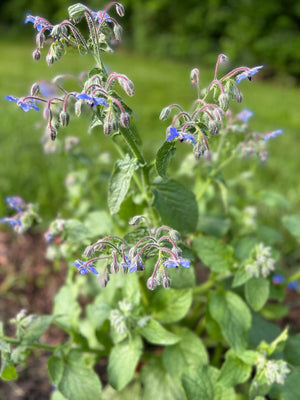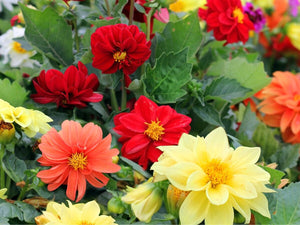Blue Perfection: How to Grow Baby Blue Eyes Flowers (Nemophila menziesii) from Seed
Blue flowers are popular but rare. So, what beautiful blue flower can you easily grow from seed? Baby Blue Eyes (Nemophila menziesii) is a native wildflower that creates a low-maintenance flower garden. These are naturally blue flowers. No dye here.

How to Grow Baby Blue Eyes Flowers from Seed
Baby Blue Eyes Flowers (Nemophila menziesii) have a small bowl-shaped flower blossom with a white center. They grow well in temperate climates and are native to California, although they can grow in many locations.
Like most wildflowers, starting Baby Blue Eyes from seed is fairly easy. And they will self-sow. When you plant a whole meadow of these flowers, let them drop their seeds to come back year after year.
This California native is a favorite in a wildflower garden. Baby Blue Eyes grows low to the ground and does well throughout the United States. Nemophila menziesii produces vivid blue flowers during mild weather.

Tips for Fail-proof Baby Blue Eyes Seed Germination
Baby Blue Eyes seeds can be started indoors or outside. They’re known for not transplanting well, but if you don't disturb the roots, you can start seeds indoors and transplant seedlings.
With these seed germination tips, you can successfully start seeds indoors or direct sow.
Press seeds into moist soil or seed-starting mix
Lightly cover seeds with soil or leave them uncovered
Seeds need light to germinate
Soil should be between 55-65ºF
Keep soil moist until seeds germinate in 7 to 30 days
We grow so many seeds indoors that we often add Baby Blue Eyes to our grow station. One reason to start seeds indoors is to protect them from being eaten before they sprout. We’ve successfully started seeds indoors and directly in the garden.
Once Baby Blue Eyes seedlings have true leaves, you can transplant them outdoors. Space plants 6 to 10 inches apart.

How to Grow Baby Blue Eyes Flowers (Nemophila menziesii)
These annual wildflowers create a visually stunning landscape when grown in a large area.
Baby Blue Eyes grow 4 to 6 inches high and six to 12 inches wide. The flowers bloom on stalks that can trail over the edge of hanging baskets and rock walls. This makes them a beautiful choice for rock gardens and containers. They are also a favorite for mass plantings to create a striking blue carpet effect.
Depending on your climate, Baby Blue Eyes flowers can bloom from March to June. In warmer climates, they bloom earlier than cooler climates. They stop blooming when the summer heat arrives.
Sun
Baby Blue Eyes flowers can grow in partial shade to full sun. They often grow in open meadows or areas with dappled shade. They don’t like the heat and are usually done blooming before the hottest part of summer.
Soil
They like soil that’s more on the sandy side. But as long as your soil drains well, they will do fine.
Water
Water Baby Blue Eyes plants as needed. Small seedlings need more water until they are established.
Fertilizing
They’re a fast growing and short-term flower and don’t need extra fertilizer. If you are growing them in a wildflower area where they reseed, you could apply compost in early spring.
Solutions for pests and diseases
There aren’t any pests or diseases that are a specific problem for Baby Blue Eyes. Like other plants, they can be a target for aphids or powdery mildew.

Harvesting Baby Blue Eyes
These wildflowers aren’t used as cut flowers and are meant to be enjoyed in their natural outdoor space. Deadheading will keep the flowers from dropping their seeds and self-sowing.
Companion Flowers for Baby Blue Eyes
There are several ways to grow other flowers with Baby Blue Eyes. One easy choice is to plant them around your spring-blooming bulbs. It creates a bed of blue around the tulips, daffodils, and other flowers.
Other orange and yellow flowers can also create a striking display. California poppies bloom around the same time in many locations. You can also plant zinnias, sunflowers, cosmos, and other flowers that will bloom in the summer heat when the Baby Blue Eyes have finished flowering.

Nemophila menziesii FAQs
Is Nemophila an annual or perennial?
These native wildflowers are an annual. However, with their ability to self-seed, they can seem like a perennial.
Is Nemophila menziesii invasive?
This is a native wildflower and is not considered invasive.
Does Nemophila spread?
It doesn’t spread, but it does reseed.
Do Baby Blue Eyes come back every year?
This annual wildflower only comes back each year from the seeds it drops.
What is the bloom time for Baby Blue Eyes?
The bloom time depends on your climate. In warmer locations, Blue Eyes can start blooming in March. Cooler climates will see it blooming as late as June.
Are baby blue eyes flowers poisonous?
They are not considered toxic.
I love growing flowers that will come back year after year. Although Baby Blue Eyes Flowers are an annual, they can come back if they go to seed in a location where they have the right growing conditions. Then, without any extra effort on your part, you’ll have beautiful blue flowers in spring. Make a space to plant a blanket of Baby Blue Eyes from seed!






Leave a comment